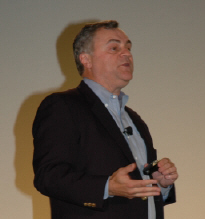IBM's Mills: service orientation essential for new business growth

At this week's IBM Impact conference in Las Vegas -- where SOA and BPM [business process management] are the hottest acronyms around -- I had the opportunity to sit down with Steve Mills, senior vice president and group executive of IBM's Software Group. 
SOA has been in various stages of evolution over the past decade, and as Mills discussed, it is built on the shoulders of past efforts at distributed computing architectures.
But now, things are getting really interesting, he says. Businesses are seeking agility by relying on services from across the network spectrum -- whether it is from their own internal IT departments, or from partners or other outside providers. This is changing the role of IT in organizations, and changing the organizations themselves.
Interestingly, many businesses offer services to partners in a big way -- cloud computing, essentially -- but don't dare call it "cloud." For example, he says, ADP has been doing for years what cloud providers have just started doing -- offering online business services to customers. "Nobody in the venture space wants to mention ADP in the context of cloud. It sorts of demystifies the mystical magical cloud," he says. "That's what it is. It's a business process service. ADP's been in business for nearly 40 years. They deliver services that a huge number of people utilize as part of their primary accounting infrastructure, dealing with aspects of payroll, tax remittance, all kinds of core services. If you're part of the finance organization within your company, your cloud provider is ADP, your software as a service provider is ADP. They don't present themselves that way, but they're a long-standing cloud company."
Likewise, UPS, which provides a range of logistics and supply-chain services to customers, isn't a cloud provider -- but that's what they do, only much more deeply than typical cloud provider. "UPS is a wonderful example, 'What Can Brown do for You Today?' You understand what that model is all about. It really begins with process re-engineering," Mills explains. "UPS was founded by process engineers, not by truck drivers, and their whole approach is to look at how to make a supply chain more efficient. How to maximize stocking levels, just-in-time delivery of parts and components. They want to come in and re-engineer your process, and as part of that, they're going to actually operate part of, if not all of your process."
For companies to realize this interoperability with their business partners, and to move into the cloud effectively -- even if it's not being called a cloud -- service orientation is essential, Mills believes. "SOA is critical. If your environment is wired together very tightly, the idea that tomorrow somebody who comes along with a great service that can fit into your environment is going to be challenging for you. Because you're so wired together. The more service oriented you are, the more you can peel out specific services."
This in turn is leading to a major acceleration in the "de-verticalization" of business organizations. "Companies have been de-verticalizing for decades," Mills points out. "Henry Ford owned the iron ore mines, steel mills, and rubber plantations. In order for him to create a car back then, he had to have a full vertically integrated manufacturing infrastructure that went all the way back into the raw materials. Ford clearly doesn't operate that way today, there's no need to."
"If you look at the last 30-plus years of the evolution of the use of IT within business, you'd see an ever-increasing amount of de-verticalization," Mills says. "Companies are becoming ever more flexible and open to the idea that third-party providers of useful business process services are a convenient cost-effective way to get the job done. And that's good news, in terms of improving economics and creating greater flexibility."
Of course, with de-verticalization comes complexity, he continues. "As I look at now my corporate IT infrastructure is becoming ever more virtualized, logically virtualized in the context of where do these services come from, and now I'll need to track all these relationships, I have interdependencies that take place, I still have to deal with all my compliance." Enter SOA as we know it today, Mills says. "SOA gives us tremendous flexibility and real leverage on costs."
This, in turn, is dramatically changing the role of IT in organizations. With SOA and cloud, Mills points out, "Businesses have to spend even more time thinking about how they're going to manage all these services, and certify services, and be able to ensure that they can sustain their overall business model in context of everything they have to do to protect their brand to manage effectively. It's not that its impossible to do. It just changes the nature of what the IT organizations become responsible for. IT becomes a service aggregator, much more than a service producer."